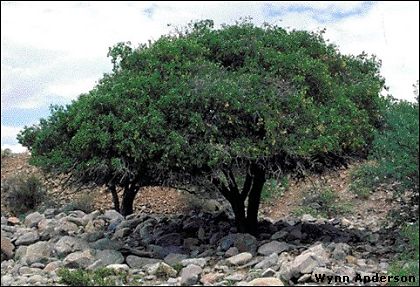
Despite its aridity, the Chihuahuan Desert supports an amazing array of trees. Sometimes, even away from the river bottoms and protected canyons, small trees stand alone or in small groups, miles from other trees. Commonly, closer inspection will reveal that such hardy plants are one or the other of two related species of hackberries. These members of the elm family are widespread throughout the desert regions of the United States and northern Mexico, supplying berries to wildlife and shade to all.
As often is the case with related plants and animals, they tend to shun
each other, having differing ecological requirements. The Desert Hackberry normally
occurs on hillsides and other areas away from waterways, while the Netleaf Hackberry
nearly always is found around areas of constant water supply, such as drainage ways.
The berries supply food to bird, beast, and man. Their hard, spherical pits, with their
sculptured surfaces, are easily identifiable and seemingly almost indestructible.
Indeed, in numerous fossil sites in our desert, moisture has destroyed all plant
remains—except for the nearly ubiquitous hackberry seed.
![]()
Contributor: Arthur H. Harris, Laboratory for Environmental Biology, Centennial Museum, University of Texas at El Paso.
Desert Diary is a joint production of the Centennial Museum and KTEP National Public Radio at the University of Texas at El Paso.

Netleaf Hackberry trees. Photograph by Wynn Anderson.
Powell, A. M. 1998. Trees and shrubs of the Trans-Pecos and adjacent areas. University of Texas Press, Austin. 498 pp.
Desert Hackberry; overview.